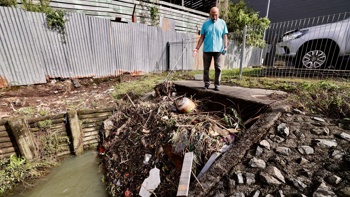
- Disabled students in Wellington say their autonomy and dignity is being taken away due to a lack of disability awareness on public transport.
- A student suffered a severe concussion after a bus driver allegedly pushed their wheelchair backwards down a ramp.
- Metlink is developing an accessibility awareness training programme in response to complaints.
A group of disabled students say their autonomy is being taken away by bus drivers, including in one serious incident which left a wheelchair-user concussed and unable to continue their study.
The Wellington student has had to pull out of university due to their severe concussion symptoms after a bus driver allegedly pushed their wheelchair backwards down a steep ramp, causing the chair to tip and the student to hit their head on the kerb.
It is just one of many incidents that students said they are experiencing on public transport in the capital.
Metlink has acknowledged that the students have not experienced dignity or received easily accessible public transport, and is developing a new accessibility awareness training programme in response to the complaints.
Hope Cotton, a co-president of the Victoria University of Wellington Disabled Students Association (VUWDSA), said accessible public transport was “crucial”.
“Disabled people have the right to access education, healthcare, and general society, for which we often rely on public transport. However, there has been a pattern of behaviour from Metlink drivers that has disregarded the agency of disabled passengers and endangered them,” she said.
“Buses and bus replacements with faulty ramps or lowering capabilities have also impeded our access. This is simply not good enough.”
 Students say Metlink drivers are refusing to lower buses or put down ramps for them. Photo / Mark Mitchell
Students say Metlink drivers are refusing to lower buses or put down ramps for them. Photo / Mark Mitchell
The incident that led to the concussion happened in mid-March and included the bus driver allegedly “manhandling” the person’s wheelchair.
“They were pushed down the wheelchair ramp backwards, despite protests from the student. Because their weight was unevenly distributed, and the wheelchair was used in an improper manner, they tipped backwards, hitting their head on the concrete curb. This compounded with previous head injuries, resulting in a severe concussion,” Cotton said.
She confirmed the student, who was not well enough to be interviewed, had now withdrawn their enrolment from the university due to the injury.
Other students have also come forward to share their stories.
Michaela, who wanted only her first name used, said she is a part-time ambulatory wheelchair user. She has chronic pain and conditions that affect her nervous system, so she regularly needs her chair to help her get around.
She experiences issues several times a week during her daily bus commute to and from university.
Often, she had to wait for several buses to go past before one would even stop to allow her on. On other occasions, drivers did not lower the bus or put down the ramp for her to get on or off.
“There was one incident where the bus driver completely refused to put it down ... I needed to do a wheelie to get off the bus. If I misjudged that I would have tipped backwards and hit my head, or tipped forwards and fallen out of my chair.”
One of the biggest recurring issues was when the buses weren’t lowered for her, so even if the ramp was put down, it was particularly steep and difficult to wheel her chair up.
 Rain Sabiston said they had to argue with bus drivers who thought they could just 'jump up' on to the bus.
Rain Sabiston said they had to argue with bus drivers who thought they could just 'jump up' on to the bus.
This led to occasions where the bus driver and sometimes other passengers suddenly started pushing her chair without asking for permission or communicating that they were going to do so.
“It can be quite frightening without realising somebody’s behind me,” she said.
When someone pushed her chair without permission, she lost control of where she was going, and often couldn’t even see who was doing the pushing.
One time, the bus driver started pushing her from behind while a passenger pulled the front of her chair up the ramp.
“That was really undignifying and really embarrassing. I just want to be able to go on public transport safely with dignity and not have to stress about whether I’m going to be able to get on the public transport.”
Michaela often felt “quite anxious” about her commute, and felt she had to plan in advance more.
“I will often have to wait through multiple buses going past because they can’t fit me on.”
She felt generally stressed about getting on and off the bus. “It just adds a lot of mental stress, which I really don’t need. I’m just trying to live my life, access my education, catch up with friends, all that kind of stuff.”
George Bronlund uses a powered wheelchair and needs a hoist to get on to the Wairarapa train when he takes it.
On one occasion, he was hoisted on to the train and informed the staff which station he would need to be taken off at.
But when the train stopped at the station, he was forgotten about.
 George Bronlund needs a hoist to get on and off the Wairarapa train.
George Bronlund needs a hoist to get on and off the Wairarapa train.
“I positioned myself near the hoist, awaiting assistance, and the train took off without anybody disembarking me,” he said.
The staff then had to disembark him at a slightly “isolated” station where he had to wait for someone to collect him.
He has also had issues involving not being allowed on some buses because they lack enough room for his chair.
“They advise me that a van will be coming to collect me, but sometimes it doesn’t show up.”
Rain Sabiston uses a cane and occasionally a friend’s wheelchair, and also faces issues where bus drivers won’t lower the bus or put down a ramp.
While drivers sometimes assumed it would be simple for Sabiston to step a bit higher, this could cause them to partially dislocate their hip.
“I have to explain I can’t jump up. It’s horrible having to argue just to get on ... without getting injured.
“I have to first worry about getting on to the bus. From there, I have to worry about getting a seat because I can’t stand for bus rides.”
There were also issues with bus drivers taking off before Sabiston could sit down, sometimes causing them to fall, or with other people physically trying to help them without asking first.
Metlink group manager Samantha Gain said they treated complaints such as these “very seriously”.
“Our vision is for a public transport network that is ‘accessible for all with ease and dignity’, and we recognise that these passengers have not had this experience,” she said.
Last week, Metlink staff met with representatives of VUWDSA to listen to the students’ personal accounts and acknowledge their impact.
They also discussed how Metlink could improve services for disabled passengers.
“Metlink is in the process of engaging a specialist training provider to co-design, develop and deliver an accessibility awareness training programme. The majority of the panel selecting this provider are people who collectively have a range of disabilities."
Cotton said they were grateful to have met with Metlink and the Greater Wellington Regional Council to discuss concerns.
“We are excited to hear about their new accessibility awareness training, and hope this will lead to travel that is safe, accessible and dignified.”
Melissa Nightingale is a Wellington-based reporter who covers crime, justice and news in the capital. She joined the Herald in 2016 and has worked as a journalist for 10 years.
Take your Radio, Podcasts and Music with you









